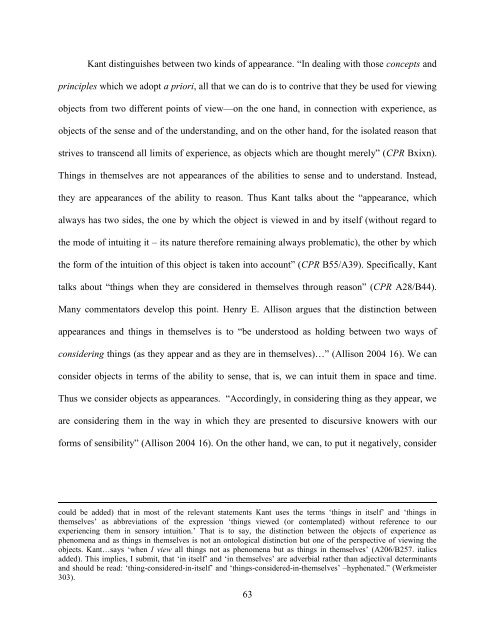stankovic, sasa thesis.pdf - Atrium - University of Guelph
stankovic, sasa thesis.pdf - Atrium - University of Guelph
stankovic, sasa thesis.pdf - Atrium - University of Guelph
You also want an ePaper? Increase the reach of your titles
YUMPU automatically turns print PDFs into web optimized ePapers that Google loves.
Kant distinguishes between two kinds <strong>of</strong> appearance. “In dealing with those concepts and<br />
principles which we adopt a priori, all that we can do is to contrive that they be used for viewing<br />
objects from two different points <strong>of</strong> view—on the one hand, in connection with experience, as<br />
objects <strong>of</strong> the sense and <strong>of</strong> the understanding, and on the other hand, for the isolated reason that<br />
strives to transcend all limits <strong>of</strong> experience, as objects which are thought merely” (CPR Bxixn).<br />
Things in themselves are not appearances <strong>of</strong> the abilities to sense and to understand. Instead,<br />
they are appearances <strong>of</strong> the ability to reason. Thus Kant talks about the “appearance, which<br />
always has two sides, the one by which the object is viewed in and by itself (without regard to<br />
the mode <strong>of</strong> intuiting it – its nature therefore remaining always problematic), the other by which<br />
the form <strong>of</strong> the intuition <strong>of</strong> this object is taken into account” (CPR B55/A39). Specifically, Kant<br />
talks about “things when they are considered in themselves through reason” (CPR A28/B44).<br />
Many commentators develop this point. Henry E. Allison argues that the distinction between<br />
appearances and things in themselves is to “be understood as holding between two ways <strong>of</strong><br />
considering things (as they appear and as they are in themselves)…” (Allison 2004 16). We can<br />
consider objects in terms <strong>of</strong> the ability to sense, that is, we can intuit them in space and time.<br />
Thus we consider objects as appearances. “Accordingly, in considering thing as they appear, we<br />
are considering them in the way in which they are presented to discursive knowers with our<br />
forms <strong>of</strong> sensibility” (Allison 2004 16). On the other hand, we can, to put it negatively, consider<br />
could be added) that in most <strong>of</strong> the relevant statements Kant uses the terms ‘things in itself’ and ‘things in<br />
themselves’ as abbreviations <strong>of</strong> the expression ‘things viewed (or contemplated) without reference to our<br />
experiencing them in sensory intuition.’ That is to say, the distinction between the objects <strong>of</strong> experience as<br />
phenomena and as things in themselves is not an ontological distinction but one <strong>of</strong> the perspective <strong>of</strong> viewing the<br />
objects. Kant…says ‘when I view all things not as phenomena but as things in themselves’ (A206/B257. italics<br />
added). This implies, I submit, that ‘in itself’ and ‘in themselves’ are adverbial rather than adjectival determinants<br />
and should be read: ‘thing-considered-in-itself’ and ‘things-considered-in-themselves’ –hyphenated.” (Werkmeister<br />
303).<br />
63

















